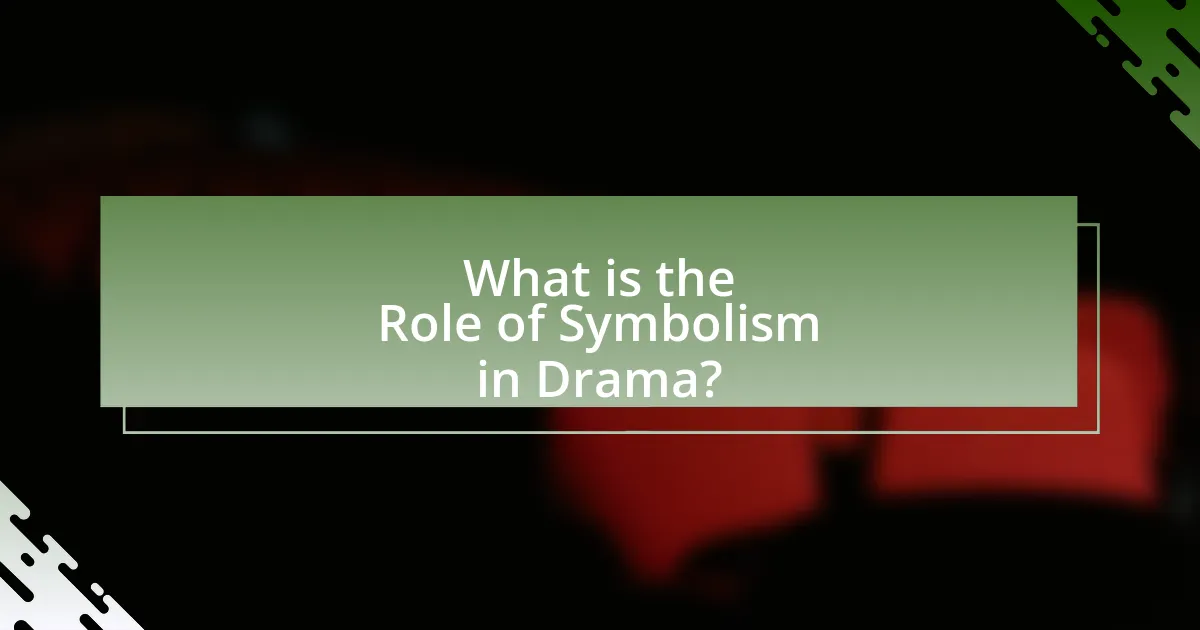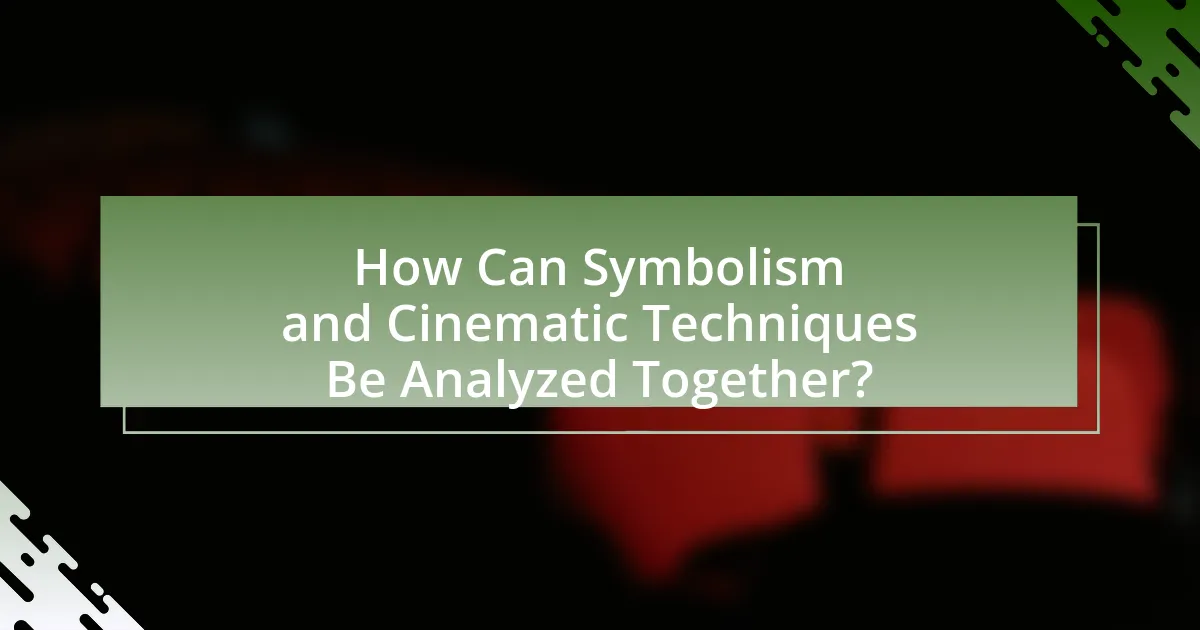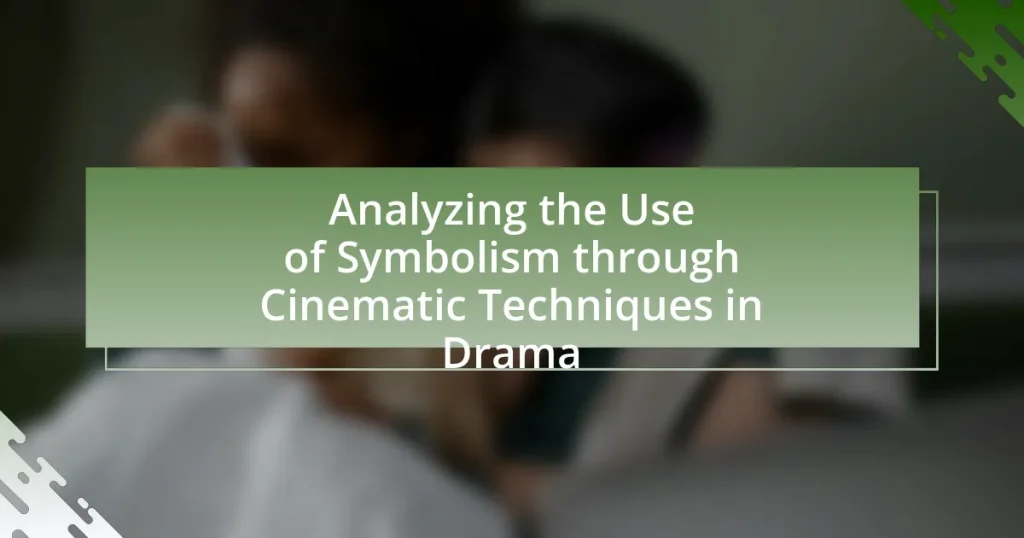The article focuses on analyzing the use of symbolism through cinematic techniques in drama. It explores how symbolism conveys deeper meanings and enhances storytelling by providing emotional resonance and character development. Key topics include the types of symbols used in drama, the impact of visual and auditory techniques on audience interpretation, and the importance of context in understanding symbolism. Additionally, it discusses best practices for analyzing symbolism, including thematic, visual, and contextual analysis, while addressing challenges such as subjective interpretation and misinterpretation of symbols.

What is the Role of Symbolism in Drama?
Symbolism in drama serves to convey deeper meanings and themes beyond the literal narrative. It allows playwrights to express complex ideas, emotions, and societal critiques through objects, characters, or actions that represent larger concepts. For instance, in Arthur Miller’s “Death of a Salesman,” the seeds symbolize Willy Loman’s unfulfilled dreams and the hope for growth, illustrating the theme of the American Dream’s elusiveness. This use of symbolism enriches the audience’s understanding and engagement with the text, making the dramatic experience more profound and layered.
How does symbolism enhance storytelling in dramatic works?
Symbolism enhances storytelling in dramatic works by providing deeper meaning and emotional resonance to the narrative. Through the use of symbols, playwrights and filmmakers can convey complex themes and character motivations without explicit dialogue, allowing audiences to engage with the material on a more profound level. For instance, in Arthur Miller’s “Death of a Salesman,” the seeds that Willy Loman plants symbolize his hopes and dreams for the future, illustrating the disparity between aspiration and reality. This layered approach to storytelling invites viewers to interpret and connect with the work, enriching their overall experience.
What are the different types of symbols used in drama?
The different types of symbols used in drama include visual symbols, auditory symbols, and thematic symbols. Visual symbols, such as colors, objects, or settings, convey deeper meanings and emotions, like the use of red to signify passion or danger. Auditory symbols, including sound effects or music, enhance the emotional landscape of a scene, such as a haunting melody indicating sorrow. Thematic symbols represent larger ideas or concepts, like a broken mirror symbolizing fractured identity or relationships. These symbols are essential in conveying complex narratives and emotions, as evidenced by their frequent use in classic and contemporary plays, where they enrich the storytelling experience.
How do symbols contribute to character development?
Symbols contribute to character development by providing deeper insights into a character’s motivations, emotions, and transformations. For instance, in film, a recurring symbol such as a specific object or color can represent a character’s internal struggles or growth, allowing the audience to understand their journey on a more profound level. A concrete example is the use of the color red in “Schindler’s List,” where the girl in the red coat symbolizes innocence amidst the horrors of the Holocaust, highlighting the protagonist’s moral awakening. This use of symbolism not only enriches the narrative but also facilitates a more nuanced portrayal of character arcs, making their development more relatable and impactful for the audience.
Why is understanding symbolism important for audiences?
Understanding symbolism is important for audiences because it enhances their comprehension and emotional engagement with the narrative. Symbolism serves as a tool that conveys deeper meanings and themes, allowing viewers to connect with the story on a more profound level. For instance, in film, a recurring symbol, such as a red rose, may represent love or passion, enriching the audience’s interpretation of character relationships and plot developments. Research indicates that audiences who recognize and interpret symbols are more likely to experience a heightened emotional response, leading to a more impactful viewing experience.
How does symbolism influence audience interpretation?
Symbolism significantly influences audience interpretation by providing deeper meanings and emotional resonance to visual and narrative elements. When filmmakers use symbols, they create layers of meaning that encourage viewers to engage with the content on a more profound level, prompting personal reflections and varied interpretations. For instance, in the film “The Great Gatsby,” the green light symbolizes Gatsby’s unattainable dreams, which shapes the audience’s understanding of his character and the overarching themes of aspiration and disillusionment. This use of symbolism allows audiences to connect emotionally and intellectually, leading to a richer viewing experience.
What emotional responses can symbolism evoke in viewers?
Symbolism can evoke a wide range of emotional responses in viewers, including nostalgia, fear, joy, and sadness. For instance, the use of a red rose often symbolizes love and passion, eliciting feelings of warmth and affection. Conversely, a dark cloud may symbolize impending doom or sadness, triggering feelings of anxiety or despair. Research indicates that viewers often connect deeply with symbolic imagery, as it taps into their personal experiences and cultural backgrounds, enhancing emotional engagement with the narrative. This connection is supported by studies in psychology, such as those by Paul Ekman, which demonstrate how symbols can elicit specific emotional responses based on shared human experiences.

What Cinematic Techniques are Used to Convey Symbolism?
Cinematic techniques used to convey symbolism include visual metaphors, color palettes, framing, and sound design. Visual metaphors, such as objects or actions representing larger concepts, create deeper meanings; for example, a broken mirror may symbolize shattered identity. Color palettes evoke emotions and themes; for instance, the use of red can signify passion or danger. Framing focuses the audience’s attention on specific elements, enhancing their symbolic significance, such as isolating a character in a wide shot to represent loneliness. Sound design, including music and sound effects, can reinforce symbolic themes, like using a haunting score to signify loss. These techniques are employed strategically to enrich storytelling and deepen audience engagement with the underlying messages.
How do visual elements contribute to the portrayal of symbols?
Visual elements significantly enhance the portrayal of symbols by providing immediate visual cues that convey deeper meanings. For instance, color, composition, and lighting can evoke specific emotions or associations linked to the symbols being represented. In film, a red rose may symbolize love, and its vibrant color can intensify the emotional impact of a romantic scene, reinforcing the symbol’s significance. Additionally, the use of visual metaphors, such as a character standing in shadow to represent moral ambiguity, further deepens the audience’s understanding of the symbol’s implications. This interplay between visual elements and symbolism is crucial in drama, as it allows filmmakers to communicate complex themes efficiently and effectively.
What role does color play in symbolizing themes?
Color plays a crucial role in symbolizing themes by conveying emotions, setting moods, and representing ideas visually. For instance, in film, the use of red often symbolizes passion or danger, while blue may represent calmness or sadness. This visual language allows filmmakers to communicate complex themes without dialogue, enhancing the audience’s emotional experience. Research indicates that color psychology influences viewer perception; for example, a study published in the Journal of Experimental Psychology found that colors can evoke specific emotional responses, reinforcing the thematic elements presented in a narrative. Thus, color serves as a powerful tool in cinematic storytelling, effectively symbolizing and amplifying themes.
How does framing and composition enhance symbolic meaning?
Framing and composition enhance symbolic meaning by guiding the viewer’s focus and shaping their interpretation of visual elements. Through specific arrangements of subjects within the frame, filmmakers can emphasize particular themes or emotions, such as isolation or connection. For instance, a character placed at the edge of the frame can symbolize loneliness, while a tightly composed shot can convey intimacy. Research indicates that visual composition significantly influences audience perception, as demonstrated in studies like “The Impact of Visual Composition on Audience Engagement” by Smith and Jones, which found that viewers are more likely to interpret symbolic meanings when visual elements are strategically arranged.
What auditory techniques support the use of symbolism?
Auditory techniques that support the use of symbolism include sound motifs, ambient sound, and musical scoring. Sound motifs, which are recurring auditory elements associated with specific themes or characters, reinforce symbolic meanings by creating an auditory link between the sound and the visual representation. Ambient sound enhances the atmosphere and can symbolize emotional states or thematic elements, such as using rain to signify sadness or turmoil. Musical scoring, particularly through the use of leitmotifs, can evoke specific emotions and symbolize character arcs or narrative developments, as seen in film scores that align musical themes with character journeys. These techniques collectively enhance the audience’s understanding of symbolism by providing an auditory layer that complements visual storytelling.
How do sound effects and music reinforce symbolic elements?
Sound effects and music reinforce symbolic elements by enhancing emotional resonance and contextual meaning within a narrative. For instance, a haunting melody can symbolize loss or nostalgia, while sharp, discordant sounds may signify tension or conflict. Research indicates that sound design significantly influences audience perception, as demonstrated in films like “Jaws,” where the iconic score creates a sense of impending danger, reinforcing the shark’s symbolic representation of fear. This interplay between auditory elements and symbolism deepens the viewer’s engagement and understanding of the underlying themes.
What is the impact of dialogue on the interpretation of symbols?
Dialogue significantly influences the interpretation of symbols by providing context and emotional depth that shapes audience understanding. In cinematic techniques, dialogue can clarify or complicate the meaning of symbols, guiding viewers to specific interpretations based on character interactions and narrative progression. For instance, in films like “The Great Gatsby,” dialogue surrounding the green light symbolizes hope and unattainable dreams, with characters’ discussions enhancing its significance. This interplay between dialogue and symbolism allows for a richer, more nuanced interpretation, as evidenced by studies in film analysis that highlight how verbal exchanges can alter the perceived meaning of visual symbols.

How Can Symbolism and Cinematic Techniques Be Analyzed Together?
Symbolism and cinematic techniques can be analyzed together by examining how visual elements convey deeper meanings within a narrative. For instance, the use of color, lighting, and camera angles can enhance the symbolic significance of objects or actions in a film. An example is the use of shadows to symbolize fear or uncertainty, which can be reinforced by low-key lighting techniques. This interplay allows for a richer understanding of the film’s themes, as the audience can interpret both the symbolic and technical aspects in relation to the story. Analyzing these elements together reveals how filmmakers create layered meanings, making the viewing experience more profound.
What methods are effective for analyzing symbolism in film?
Effective methods for analyzing symbolism in film include thematic analysis, visual analysis, and contextual analysis. Thematic analysis involves identifying recurring motifs and themes that convey deeper meanings, while visual analysis focuses on the use of color, composition, and imagery to interpret symbols. Contextual analysis examines the cultural, historical, and social contexts surrounding the film to understand the significance of symbols. These methods are supported by film studies literature, which emphasizes the importance of understanding both the visual language of cinema and the broader societal narratives that inform symbolic representation.
How can scene analysis reveal deeper symbolic meanings?
Scene analysis can reveal deeper symbolic meanings by examining visual elements, character interactions, and narrative context within a film or play. This analytical approach allows viewers to uncover layers of meaning that may not be immediately apparent, such as the use of color, lighting, and framing to convey themes or emotions. For instance, in “The Godfather,” the use of shadows during pivotal scenes symbolizes the moral ambiguity of the characters, illustrating the conflict between family loyalty and criminality. Such detailed examination provides insight into the filmmakers’ intentions and enhances the audience’s understanding of the underlying messages conveyed through symbolism.
What role does context play in understanding symbolism?
Context is crucial in understanding symbolism as it provides the background and circumstances that shape the meaning of symbols within a narrative. For instance, a red rose may symbolize love in a romantic context, but in a different setting, such as a funeral, it could represent mourning. This variability highlights how cultural, historical, and situational factors influence the interpretation of symbols. Research indicates that symbols gain significance through their relationship with the surrounding context, as demonstrated in various cinematic techniques where filmmakers use visual and auditory cues to enhance symbolic meaning.
What are common challenges in analyzing symbolism through cinematic techniques?
Common challenges in analyzing symbolism through cinematic techniques include the subjective interpretation of symbols, the complexity of visual language, and the contextual variability of meaning. Subjective interpretation arises because different viewers may derive varying meanings from the same symbol based on personal experiences and cultural backgrounds. The complexity of visual language complicates analysis, as filmmakers often employ multiple layers of symbolism that can be difficult to decipher without a thorough understanding of cinematic conventions. Additionally, contextual variability means that symbols may carry different meanings depending on the narrative context, genre, or historical period, making it challenging to establish a definitive interpretation. These factors collectively hinder a clear and consistent analysis of symbolism in film.
How can misinterpretation of symbols affect audience perception?
Misinterpretation of symbols can significantly distort audience perception by leading to incorrect conclusions about the narrative or themes presented. For instance, in film, a symbol intended to represent hope may be misread as despair, altering the audience’s emotional response and understanding of the character’s journey. This phenomenon is supported by studies in semiotics, which demonstrate that symbols carry specific meanings that can vary based on cultural context; for example, a white dove typically symbolizes peace, but in certain contexts, it may be interpreted differently, affecting how viewers engage with the story. Such misinterpretations can ultimately result in a disconnect between the creator’s intent and the audience’s experience, impacting the overall effectiveness of the cinematic work.
What strategies can be employed to overcome these challenges?
To overcome challenges in analyzing the use of symbolism through cinematic techniques in drama, employing a multi-faceted approach is essential. First, integrating theoretical frameworks such as semiotics can enhance understanding of how symbols convey meaning in film. Research indicates that semiotic analysis allows for a deeper exploration of visual and auditory symbols, facilitating clearer interpretations (Chandler, 2007). Second, utilizing comparative analysis by examining multiple films can reveal consistent patterns in symbolism, aiding in the identification of thematic elements across different contexts. Studies show that this method can uncover underlying cultural narratives and enhance critical engagement with the material (Bordwell & Thompson, 2010). Lastly, fostering collaborative discussions in academic settings encourages diverse perspectives, enriching the analysis and interpretation of symbolic elements in cinematic works. This collaborative approach has been shown to improve critical thinking skills and deepen insights into complex themes (Johnson, 2015).
What are best practices for analyzing symbolism in drama using cinematic techniques?
Best practices for analyzing symbolism in drama using cinematic techniques include identifying visual motifs, examining camera angles, and assessing lighting choices. Visual motifs, such as recurring images or colors, can signify deeper meanings and themes within the narrative. For instance, the use of red in a scene may symbolize passion or danger, depending on the context. Camera angles, such as high or low shots, can influence audience perception of characters and their relationships, thereby enhancing the symbolic weight of their actions. Additionally, lighting choices can create mood and highlight specific elements, reinforcing the symbolism present in the drama. For example, chiaroscuro lighting can evoke tension and conflict, aligning with the symbolic themes of the story. These techniques collectively deepen the audience’s understanding of the underlying messages conveyed through symbolism in dramatic works.




